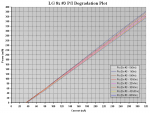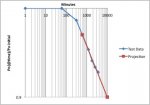Couldn't do this sooner, too busy..
Here are the 60h degradation plots:
Diode Stats:
- Ith = 37mA
- Po @ 300mA = 330mA (92.7% of initial power)
- Slope Efficiency = 1.254mW/mA
- Actual Efficiency = 18.81% Peak / 18.51% Avg.
Degradation has slowed down to a point, where it's hard to discern PI plots, even tho almost 20h passed since the last one.
The slope efficiency was actually calculated to be the same as before. The only reason the new plot ended somewhat lower is, that Ith was measured higher than before.
Basically, the slope is the same as before, only difference is, that the entire plot is shifted to the right by 1mA....
Interestingly, the efficiency plots show much more of a difference, but i should mention, that the previous one (yellow line) doesn't fit in.
This is most likelly due to temperature differences. It resulted in some errors, that are hard to explain.
The temperature was higher when i recorded the 42h plot - 26°C instead of 21°C. This should have resulted in a lower efficiency. But the Vf drops first as the temperature climbs, while the power drops much more slowly. Due to a lower Vf, the El. input power was lower, while the output power was almost the same, so the calculated efficiency actually came out higher!
This is somewhat confusing, i'd expect it to be the other way around...
I'll have to do some plots of a healthy diode at different temperatures, to explore this behavior in more detail.
Anyway, this is it for now, the diode is still alive and well. I might have to spread out the re-plotting intervals even more, to detect measurable differences next time.
Back to work for now, otherwise i'm getting parts to expand the torture chamber tomorrow...







